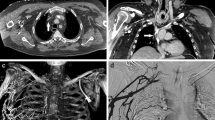Abstract
Purpose
To demonstrate the effectiveness of endovascular treatment (EVT) with self-expandable bare stents for malignant superior vena cava syndrome (SVCS) and to analyze predictive factors of EVT efficacy.
Methods
Retrospective review of the 164 patients with malignant SVCS treated with EVT in our hospital from August 1992 to December 2007 and followed until February 2009. Endovascular treatment includes angioplasty before and after stent placement. We used self-expandable bare stents. We studied results of this treatment and looked for predictive factors of clinical efficacy, recurrence, and complications by statistical analysis.
Results
Endovascular treatment was clinically successful in 95% of cases, with an acceptable rate of early mortality (2.4%). Thrombosis of the superior vena cava was the only independent factor for EVT failure. The use of stents over 16 mm in diameter was a predictive factor for complications (P = 0.008). Twenty-one complications (12.8%) occurred during the follow-up period. Relapse occurred in 36 patients (21.9%), with effective restenting in 75% of cases. Recurrence of SVCS was significantly increased in cases of occlusion (P = 0.01), initial associated thrombosis (P = 0.006), or use of steel stents (P = 0.004). Long-term anticoagulant therapy did not influence the risk of recurrence or complications.
Conclusion
In malignancy, EVT with self-expandable bare stents is an effective SVCS therapy. These results prompt us to propose treatment with stents earlier in the clinical course of patients with SVCS and to avoid dilatation greater than 16 mm.



Similar content being viewed by others
References
Wilson LD, Detterbeck FC, Yahalom J (2007) Clinical practice: superior vena cava syndrome with malignant causes. N Engl J Med 356:1862–1869
Watkinson AF, Yeow TN, Fraser C (2008) Endovascular stenting to treat obstruction of the superior vena cava. Bmj 336(7658):1434–1437
Ostler PJ, Clarke DP, Watkinson AF et al (1997) Superior vena cava obstruction: a modern management strategy. Clin Oncol (R Coll Radiol) 9:83–89
Kee ST, Kinoshita L, Razavi MK et al (1998) Superior vena cava syndrome: treatment with catheter-directed thrombolysis and endovascular stent placement. Radiology 206:187–193
Uberoi R (2006) Quality assurance guidelines for superior vena cava stenting in malignant disease. Cardiovasc Intervent Radiol 29:319–322
Rowell NP, Gleeson FV (2002) Steroids, radiotherapy, chemotherapy and stents for superior vena caval obstruction in carcinoma of the bronchus: a systematic review. Clin Oncol (R Coll Radiol) 14:338–351
Urruticoechea A, Mesia R, Dominguez J et al (2004) Treatment of malignant superior vena cava syndrome by endovascular stent insertion. Experience on 52 patients with lung cancer. Lung Cancer 43:209–214
Lanciego C, Pangua C, Chacon JI et al (2009) Endovascular stenting as the first step in the overall management of malignant superior vena cava syndrome. AJR Am J Roentgenol 193:549–558
Berna P, Bagan P, Renard C et al (2008) Pulmonary malignant superior vena cava obstruction: endovascular stent therapy. Rev Pneumol Clin 64:129–132
de Gregorio Ariza MA, Gamboa P, Gimeno MJ et al (2003) Percutaneous treatment of superior vena cava syndrome using metallic stents. Eur Radiol 13:853–862
Dinkel HP, Mettke B, Schmid F et al (2003) Endovascular treatment of malignant superior vena cava syndrome: is bilateral wallstent placement superior to unilateral placement? J Endovasc Ther 10:788–797
Shah R, Sabanathan S, Lowe RA et al (1996) Stenting in malignant obstruction of superior vena cava. J Thorac Cardiovasc Surg 112:335–340
Lanciego C, Chacon JL, Julian A et al (2001) Stenting as first option for endovascular treatment of malignant superior vena cava syndrome. Am J Roentgenol 177:585–593
Marcy PY, Ianessi A, Poudenx M (2009) Percutaneous management of SVC syndrome: update. J Radiol 90(3 pt 1):335–338
Nagata T, Makutani S, Uchida H et al (2007) Follow-up results of 71 patients undergoing metallic stent placement for the treatment of a malignant obstruction of the superior vena cava. Cardiovasc Intervent Radiol 30:959–967
Kishi K, Sonomura T, Mitsuzane K et al (1993) Self-expandable metallic stent therapy for superior vena cava syndrome: clinical observations. Radiology 189:531–535
Smayra T, Otal P, Chabbert V et al (2001) Long-term results of endovascular stent placement in the superior caval venous system. Cardiovasc Intervent Radiol 24:388–394
Nguyen NP, Borok TL, Welsh J et al (2009) Safety and effectiveness of vascular endoprosthesis for malignant superior vena cava syndrome. Thorax 64:174–178
Ganeshan A, Hon LQ, Warakaulle DR et al (2009) Superior vena caval stenting for SVC obstruction: current status. Eur J Radiol 71:343–349
Furui S, Sawada S, Kuramoto K et al (1995) Gianturco stent placement in malignant caval obstruction: analysis of factors for predicting the outcome. Radiology 195:147–152
Tanigawa N, Sawada S, Mishima K et al (1998) Clinical outcome of stenting in superior vena cava syndrome associated with malignant tumours. Comparison with conventional treatment. Acta Radiol 39:669–674
Thony F, Moro D, Witmeyer P et al (1999) Endovascular treatment of superior vena cava obstruction in patients with malignancies. Eur Radiol 9:965–971
Wilson E, Lyn E, Lynn A et al (2002) Radiological stenting provides effective palliation in malignant central venous obstruction. Clin Oncol (R Coll Radiol) 14:228–232
Oudkerk M, Heystraten FM, Stoter G (1993) Stenting in malignant vena caval obstruction. Cancer 71:142–146
Gross CM, Kramer J, Waigand J et al (1997) Stent implantation in patients with superior vena cava syndrome. AJR Am J Roentgenol 169:429–432
Acknowledgments
We thank Dr. A. Foote (Grenoble Clinical Research Centre) for translation services.
Conflict of interest
The authors declare that they have no conflict of interest.
Author information
Authors and Affiliations
Corresponding author
Rights and permissions
About this article
Cite this article
Fagedet, D., Thony, F., Timsit, JF. et al. Endovascular Treatment of Malignant Superior Vena Cava Syndrome: Results and Predictive Factors of Clinical Efficacy. Cardiovasc Intervent Radiol 36, 140–149 (2013). https://doi.org/10.1007/s00270-011-0310-z
Received:
Accepted:
Published:
Issue Date:
DOI: https://doi.org/10.1007/s00270-011-0310-z




